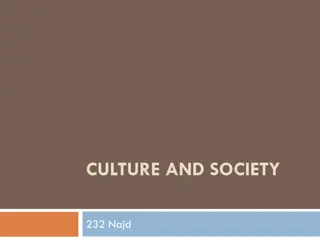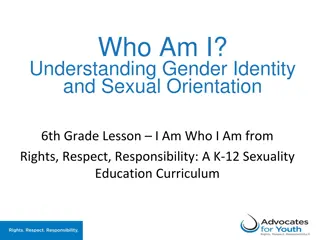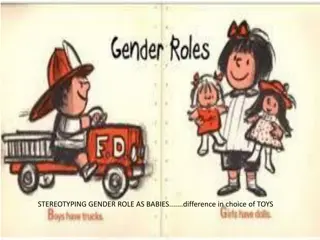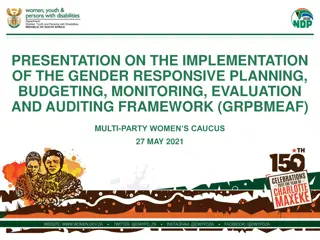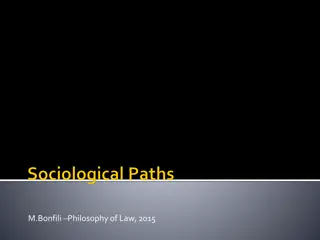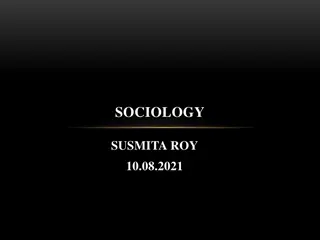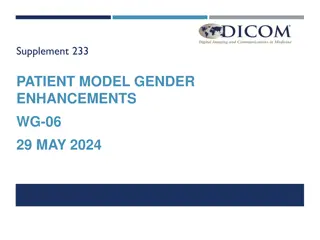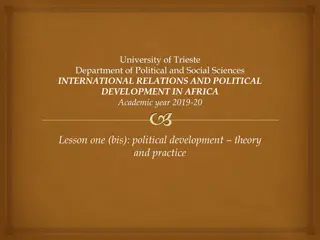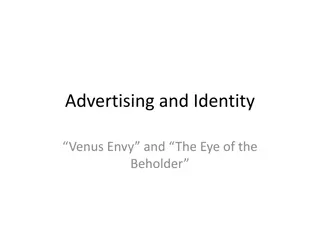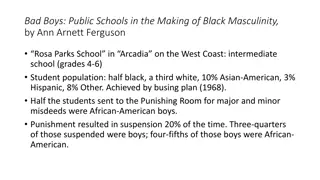Understanding Political Identity: Culture, Race & Gender in Society
Explore the intricate aspects of political identity, culture, race, ethnicity, and gender in society. Discover how individuals shape their identities and the impact of political mobilization on society. Uncover the significance of political socialization and the role of societal institutions in shaping political perspectives.
Download Presentation

Please find below an Image/Link to download the presentation.
The content on the website is provided AS IS for your information and personal use only. It may not be sold, licensed, or shared on other websites without obtaining consent from the author. Download presentation by click this link. If you encounter any issues during the download, it is possible that the publisher has removed the file from their server.
E N D
Presentation Transcript
Chapter 6: Chapter 6: Political Identity: Culture, Political Identity: Culture, Race & Ethnicity & Gender Race & Ethnicity & Gender OER materials provided with support from the Academic Senate for California Community Colleges (ASCCC) Open Educational Resources Initiative (OERI)
Chapter Outline Chapter Outline Section #6.1: Introduction to Political Identity Section #6.2: Culture Section #6.3: Race & Ethnicity Section #6.4: Gender Section #6.5: Comparative Case Study: Gender Gaps in India and Japan
Section #6.1: Introduction to Section #6.1: Introduction to Political Identity Political Identity
6.1 Introduction to Political Identity 6.1 Introduction to Political Identity Who am I? How do I want to be seen in the future? Answers to these questions help individuals establish their sense of Identity. A person s identity is developed from a combination of factors, including a person s experiences, relationships, perception of the world, calculation of risk and threat in the world, as well as their observations and experience of societal mores, morals and values. Political identity refers to the labels and characteristics an individual chooses to associate with based on a multitude of factors including but not limited to, their perception of political ideologies, platforms and parties, as well as how they see themselves from national, racial, ethnic, linguistic, cultural and gender perspectives.
6.1 Introduction to Political Identity 6.1 Introduction to Political Identity (Continued) (Continued) One of the main reasons political scientists have begun focusing on political identity is because human attachment to these identities has been mobilized for/with political consequences. Political mobilization is defined as organized activities intended to motivate groups of participants to take political action on a particular issue. (Consider the 2010 Arab Spring or the Jan. 6th United States Capitol Attack). Image Text: A collage for Middle East & North African protests. Clockwise from top left: 2011 Egyptian revolution, Tunisian revolution, 2011 Yemeni uprising, 2011 Syrian uprising. (Source: OA collage for MENA protests. Clockwise from top left: 2011 Egyptian revolution, Tunisian revolution, 2011 Yemeni uprising, 2011 Syrian uprising., by HonorTheKing via Wikimedia Commons. is licensed under CC BY-SA 3.0.
6.1 Introduction to Political Identity 6.1 Introduction to Political Identity (Continued 2) (Continued 2) The Process of Political Socialization Society refers to a population which has organized itself based on shared ideas for how the world acts and should act through both formal and informal institutions. In living in a society, individuals become politically socialized. Political socialization is the process by which individuals perceive the political world around them, come to understand how society is organized, and how they see their own role in society based on these perceptions. Some aspects of identity tend to be fixed, and these can stem from factors such as race and biological sex (which will be discussed in the following chapters).
6.1 Introduction to Political Identity 6.1 Introduction to Political Identity (Continued 3) (Continued 3) The Process of Political Socialization How is Identity formed? Socialization with Family Socialization through School (Teachers, Peers) Socialization through News and Social Media Socialization through Religion
Section #6.2: Culture Section #6.2: Culture
6.2 Culture 6.2 Culture Culture is the combination of customs, social institutions, arts, media, and social, economic, political achievements of a social group. Norms are standard practices, rules, patterns and behaviors that are considered acceptable in a society. Political culture is defined as a shared set of ideological views and beliefs held by a population as it relates to the political system in which they live. Trust, the extent to which citizens believe in the reliability, validity, or truth of their government and their fellow citizens, plays a significant role in political outcomes.
Section #6.3: Race and Ethnicity Section #6.3: Race and Ethnicity
6.3 Race and Ethnicity 6.3 Race and Ethnicity According to Merriam-Webster, raceis a category of humankind that shares certain distinctive physical traits. To this end, race is a narrow term which is associated with biological characteristics such as skin color and hair texture. Ethnicity is a broader term than race and is used to categorize groups of people according to their own relation to culture. Racial, national, tribal, religious, linguistic and cultural origin are all factors which can be used to describe a person s ethnicity.
Section #6.4: Gender Section #6.4: Gender
6.4 Gender 6.4 Gender Gender can be broadly defined as a spectrum of characteristics ranging from feminine to masculine, and gender tends to have more to do with how a person wants to identify. Biological sex refers to the different biological and physiological characteristics of males and females, such as reproductive organs, chromosomes, hormones, etc. Sexual orientation is defined as the sustained pattern of romantic and/or sexual attraction to people of opposite sex or gender, same sex or gender, or to both.
Section #6.5: Comparative Case Section #6.5: Comparative Case Study: Gender Gaps in Japan and Study: Gender Gaps in Japan and India India
6.5 Comparative Case Study: Gender Gaps in 6.5 Comparative Case Study: Gender Gaps in Japan and India Japan and India In the post World War II period, both Japan and India moved towards Democracy, with different outcomes. Japan s Democracy is consolidated, while India s still struggles. Both countries still struggle with the advancement of women s rights and representation in society and government.
6.5 Comparative Case Study: Gender Gaps in 6.5 Comparative Case Study: Gender Gaps in Japan Japan Acceptance of a New Constitution following World War II. Previous Regime characteristics that led to acceptance of New Constitution. While great advancements have been made, there is still a substantial gender gap in Japan for women in government, in the workplace, and in society in general. Political map of Japan (Source: Map of Japan by CIA World Factbook is licensed under Public Domain)
6.5 Comparative Case Study: Gender Gaps in 6.5 Comparative Case Study: Gender Gaps in India India Difficulty acclimating to a New Constitution and Democracy. Tremendous diversity and deep cultural divides have presented challenges to ensuring equality under the law. Like Japan, India s gender gap has continued to be significant. Political Map of India. (Source: Map of India by CIA World Factbook is licensed under Public Domain)
Summary Summary
Summary 1 Summary 1 Political identity refers to the labels and characteristics an individual chooses to associate with based on a multitude of factors including but not limited to, their perception of political ideologies, platforms and parties, as well as how they see themselves from national, racial, ethnic, linguistic, cultural and gender perspectives. Culture is the combination of customs, social institutions, arts, media, and social, economic, political achievements of a social group. Race and ethnicity play a major role in politics around the world. Factors of race and ethnicity can be explored as both an influence on political outcomes, as well as an effect of political outcomes.
Summary 2 Summary 2 Relating to biological sex, the divide between male and female has often influenced politics. Most frequently, women in most societies have been historically underrepresented and discriminated against. Another factor of concern in this area is acceptance of gender identity in different political systems. Japan and India are both democracies with new constitutions formed in the post World War II period. Within both countries constitutions, there is emphasis on both equal treatment under the law for all citizens, as well as freedom from discrimination based on race, religion, sex, and other factors of importance in both societies. Nevertheless, both countries have struggled with large gender gaps in relation to women in the workplace, women s earnings with equal credentials and positions as men, access to healthcare, and representation in politics.





